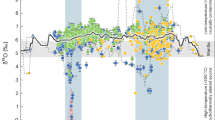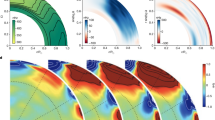Abstract
THE recently published discovery of the lithium resonance line in the twilight airglow by Delannoy and Weill1 and further observations of the emission by Gadsden and Salmon2 have led to a discussion as to the origin of the lithium atoms in the upper atmosphere. Barbier, Delannoy and Weill3 have considered the possibility of marine and meteoric origins for the lithium and have favoured the latter hypothesis because the derived abundance ratio lithium/sodium agreed better with the ratio for the meteoric material. Donahue4 has suggested that the lack of linearity in the relation between sodium brightness and abundance could make ambiguous any conclusions based on the lithium/sodium brightness ratio alone. A third possibility suggested by the U.S.A. International Geophysical Year Committee5, and supported further by Barber6, is that the lithium originates from ‘hydrogen’ bomb tests at high altitude ; it is suggested, in particular, that the high-altitude Johnston Island test of August 1, 1958, was responsible for the lithium emissions reported by Gadsden and Salmon from Antarctica and New Zealand. In view of the uncertainty of present knowledge of the behaviour of the lithium emission, an observation from a station in the northern hemisphere should be of interest.
This is a preview of subscription content, access via your institution
Access options
Subscribe to this journal
Receive 51 print issues and online access
$199.00 per year
only $3.90 per issue
Buy this article
- Purchase on Springer Link
- Instant access to full article PDF
Prices may be subject to local taxes which are calculated during checkout
Similar content being viewed by others
References
Delannoy, J., and Weill, G., C.R. Acad. Sci., Paris, 247, 806 (1958).
Gadsden, M., and Salmon, K., Nature, 182, 1598 (1958).
Barbier, D., Delannoy, J., and Weill, G., C.R. Acad. Sci., Paris, 247, 886 (1958).
Donahue, T. M., Phys. Rev. (to be published) (I wish to thank Dr. Donahue for the opportunity of seeing his results before publication).
The Times (December 27, 1958).
Barber, D. R., Nature, 183, 384 (1959).
Petrie, W., and Small, R., Astrophys. J., 111, 555 (1950).
Hunten, D. M., J. Atmos. Terr. Phys., 5, 44 (1954).
For example, Bates, D. R., “The Earth as a Planet”, 584, edit. by Kuiper (Chicago Univ. Press, 1954).
Hunten, D. M., “The Airglow and the Auroræ”, 114, edit. by Armstrong and Dalgarno (Pergamon Press, London).
Author information
Authors and Affiliations
Rights and permissions
About this article
Cite this article
JONES, A. Observations of the Lithium Lines in the Twilight Airglow in the Northern Hemisphere. Nature 183, 1315–1316 (1959). https://doi.org/10.1038/1831315b0
Issue Date:
DOI: https://doi.org/10.1038/1831315b0
Comments
By submitting a comment you agree to abide by our Terms and Community Guidelines. If you find something abusive or that does not comply with our terms or guidelines please flag it as inappropriate.



